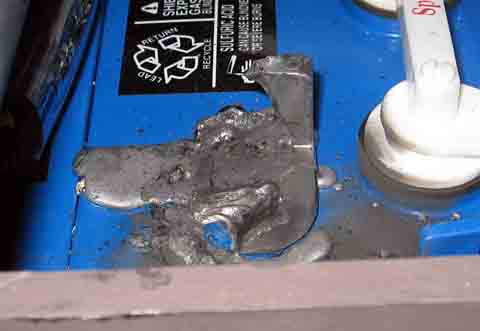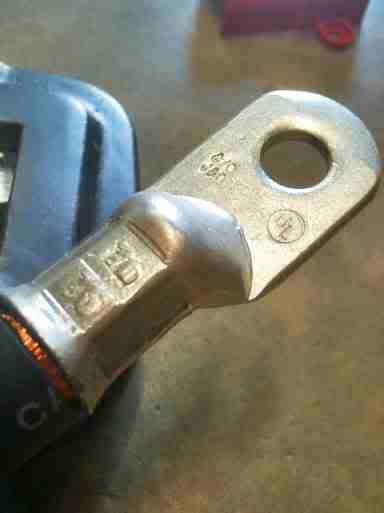I designed and built satellites for the US space industry for 34 years and NEVER ever saw or heard of a single dimple crimp. Some crimps were 4 dimples, with a $500 crimper and dies set, that had to be certified by QA every 6 months, and sample crimps at start and end of shift submitted for testing. These were for signal and control wires, of less than 1 amp, about 20 or 22 ga. Connector bodies were then epoxy potted to prevent flexing of the wire in the crimp, and strain relief was an extended backshell. For high currents (over 30A) a hydraulic crimp that fuses the copper strands together and to the barrel, can't be beat, Yes, the tool costs money, but in a budget system, how many fires or blackouts can you afford ?
A single dimple crimp (as shown) in a high amp battery cable is Trouble waiting to happen.
So I'll crimp mine and you crimp yours and I'll leave it at that.
Where to Locate one odd cable in dual parallel bank
Collapse
X
-
Leave a comment:
-
Dead wrong my friend. Properly crimped Terminals are far superior than solder. No industry practices and standards allows soldered connections. Example NEC only allows Solder if the connection does not rely on the solder for electrical or mechanical connection.Leave a comment:
-
That's just flat wrong.Toss all those cables. They look like they were crimped with a hammer & nail, and are a fire waiting to happen.
I've never seen a crimp like that before on a high amp battery cable, and I would never trust them.
-edit-
Sorry, that sounds really harsh, but I believe it to be truth, AFIK, good cable crimps are 6 sided and are about 3/4 of the entire socket
Nest-Indenter crimps are quite popular in a variety of industries. They are the only acceptable method on many military standards, for connectors that are used on fighter jets and satellites.
In addition, hex dies are only 1 type of circumferential crimp. It is more preferred in Europe, but in the US, rounded die sets are more popular in the electrical industry.
To flat out say hex crimps are the only thing that are any good is ill informed.
I'm not saying OP's crimps are perfect, as we need to know what tool was used, and also it looks like those lugs are designed for 2 crimps as opposed to the single crimp shown.Leave a comment:
-
Hmm. Simple math for a 2000 watt inverter connected to a 12volt battery could generate 167amps. Even a 1000watt inverter would get you over 80A which can create a lot of heat. So I am not sure what you mean by "not having a larger enough current to melt solder".
Any heat on the solder joint along with movement of the cable is a formula for a loose connection.Leave a comment:
-
Leave a comment:
-
Leave a comment:
-
Well I soldered my cables. I don't plan on having a large enough current to melt the solder....Leave a comment:
-
But it still has a lot lower electrical (and thermal) resistance than a poorly done and poorly understood crimp, and a lot less resistance than a simple clamp. As a practical matter, for large current carrying applications, a well designed and subsequently well executed crimp is usually the connection of choice., which can have about the same or perhaps less electrical resistance than a soldered connection as well as the practical and safety imperative mechanical and strength advantages with respect to durability. Soldered joints are better for small current carrying joints that will not be subject to much, if any movement, mechanical stress or vibration.Leave a comment:
-
Solder is not as good a conductor as copper. It does fine for minimal power communications circuits,
bonding and keeping moisture out. If it is relied on in very low impedance (battery) circuits, you may
get into trouble. Bruce RoeLeave a comment:
-
Simple answer for high current terminations. DO NOT SOLDER THEM. The heat generated from the high current will melt the solder and loosen the connection.
Solder is for low temperature applications because of its low melt point to make it flow to the wire connection. That is why it is used on PC boards or low current electrical connections. If it is easy to melt the solder to make the connection then it is easy to melt the solder to open the connection and cause a problem.Leave a comment:
-
Sorry but you are wrong here. Properly crimped lugs are crimped with such high pressure that the strands and lug fuse together. If , in the case of a high resistance connection such as a loose connection the lug can heat up to the point that the solder will liquefy and flow out of the connection similar to the melted stuff you see in the pictures. Solder is not recommended in these type connections but if it is done it should be done after properly crimping.Leave a comment:
-
Actually if his copper tube homemade terminals are soldered and yours are crimped, he has a better connection between his wire and connector and probably has less chance of a fire than yours...... assuming yours are not soldered but I am sure they are.Looks like a drunk Indian made those crimps. I can say that because I am an Indian. They cal me FBI (Fricking Big Indian). Only close friends are allowed to call me FBI. Foe gets booty kicked if they call me FBI.
Seriously those crimps will fail, most likely the first time you put a heavy current demand on them. Here is your future. Melted battery post and wire terminal. You also get a bonus prize, a nice little fire to deal with.

Here is what a proper termination looks like. See two very nice hexagon temps with proper die codes stamped by the crimper dies.

Leave a comment:
-
Looks like a drunk Indian made those crimps. I can say that because I am an Indian. They cal me FBI (Fricking Big Indian). Only close friends are allowed to call me FBI. Foe gets booty kicked if they call me FBI.
Seriously those crimps will fail, most likely the first time you put a heavy current demand on them. Here is your future. Melted battery post and wire terminal. You also get a bonus prize, a nice little fire to deal with.

Here is what a proper termination looks like. See two very nice hexagon temps with proper die codes stamped by the crimper dies.

Last edited by Sunking; 05-20-2017, 05:49 PM.Leave a comment:
-
Leave a comment:
Leave a comment: